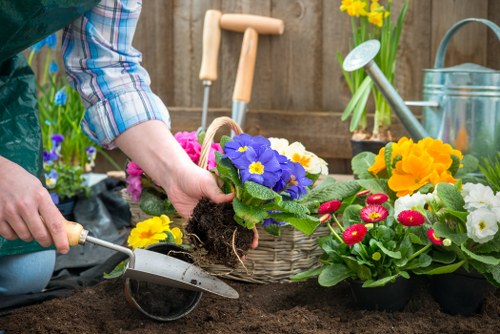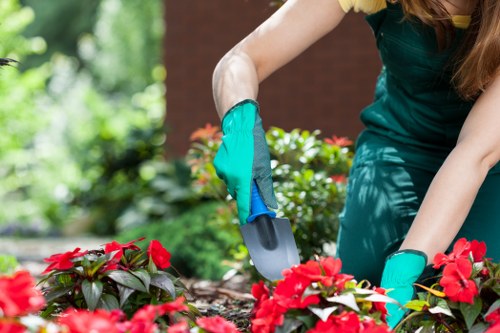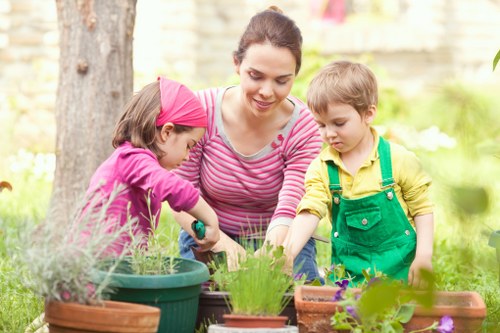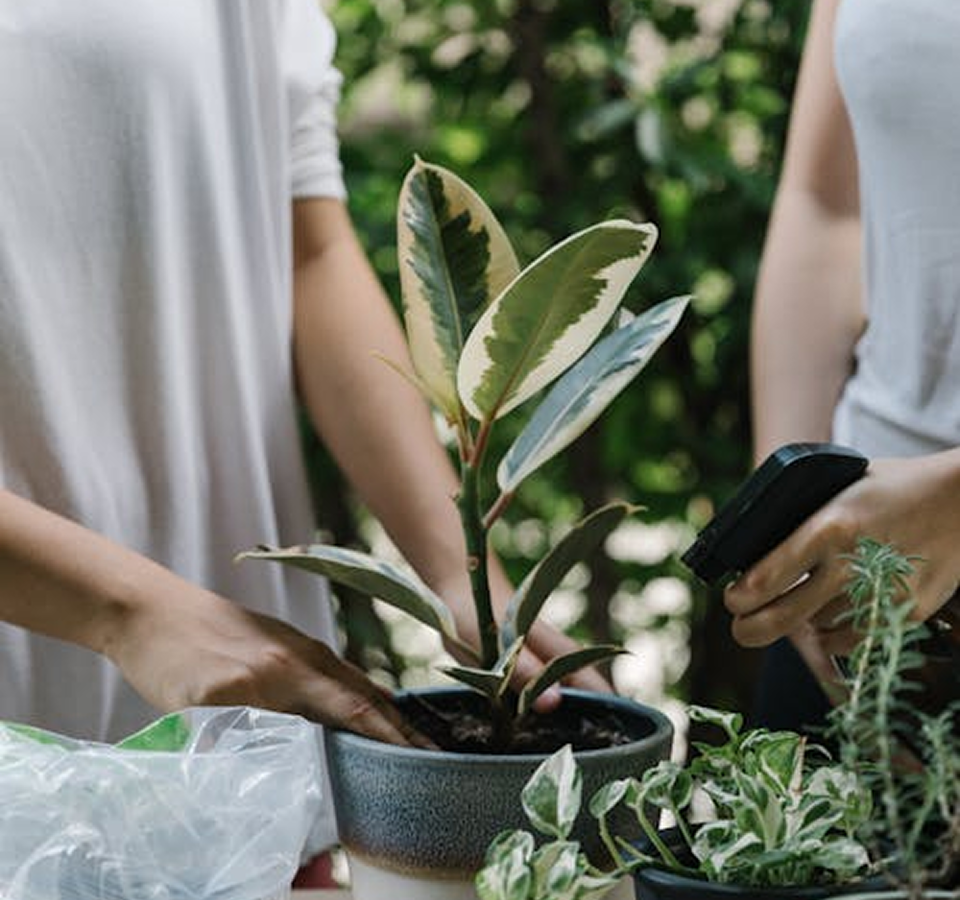Landscaping in Mitcham: Transforming Your Outdoor Spaces

Why Choose Landscaping Services in Mitcham?
Landscaping in Mitcham offers homeowners and businesses alike the opportunity to enhance their outdoor environments, adding both aesthetic appeal and functional space. With the right landscaping services in Mitcham, you can transform your yard into a beautiful retreat or create a welcoming entrance for your business.
One of the main benefits of professional landscaping is the increase in property value. A well-designed landscape not only makes your property more attractive but also boosts its market value. Additionally, quality landscaping can improve the overall health of your garden by promoting better plant growth and reducing maintenance efforts.
Moreover, landscaping contributes to environmental sustainability. By incorporating native plants and sustainable practices, landscaping in Mitcham can help in conserving water, reducing runoff, and supporting local biodiversity.

Key Elements of Effective Landscaping
1. Plant Selection
Selecting the right plants is crucial for a thriving landscape. In Mitcham, it's important to choose plants that are well-suited to the local climate and soil conditions. Consider incorporating a mix of evergreen and deciduous plants to ensure year-round interest and color.
Using native plants not only reduces maintenance but also supports local wildlife. Additionally, incorporating a variety of plant heights and textures can add depth and dimension to your landscape design.
When selecting plants, consider their growth habits, water requirements, and potential for spreading. Proper plant selection ensures a low-maintenance and sustainable landscape.
2. Hardscaping Features
Hardscaping refers to the non-plant elements in your landscape, such as patios, walkways, retaining walls, and water features. These elements provide structure and functionality to your outdoor space.
For instance, a well-designed patio can serve as an outdoor living area, perfect for entertaining guests. Walkways guide visitors through your garden, highlighting key features and ensuring safe navigation.
Retaining walls not only add visual interest but also help in managing slopes and preventing erosion. Water features like fountains or ponds can create a tranquil atmosphere and attract wildlife.

Design Tips for Landscaping in Mitcham
1. Plan for Functionality
Before starting any landscaping project, it's essential to plan how you intend to use your outdoor space. Whether it's for relaxation, entertaining, gardening, or a combination of purposes, understanding your needs will guide your design choices.
Consider creating distinct zones within your landscape, such as a dining area, a play area for children, or a serene garden corner. This approach ensures that each space serves its intended purpose effectively.
Additionally, think about the flow of movement through your garden. Pathways should be intuitive and connect different areas seamlessly.
2. Incorporate Sustainable Practices
Sustainability is becoming increasingly important in landscaping. Implementing eco-friendly practices not only benefits the environment but also reduces long-term maintenance costs.
Use mulch to retain soil moisture and suppress weeds. Installing a rainwater harvesting system can provide an additional water source for your plants. Additionally, choosing drought-resistant plants can minimize water usage.
Consider using permeable materials for pathways and patios to allow rainwater to seep into the ground, reducing runoff and promoting groundwater recharge.

Maintenance Tips for Your Mitcham Landscape
1. Regular Pruning and Trimming
Maintaining your landscape involves regular pruning and trimming of plants and shrubs. This not only keeps them looking neat but also promotes healthy growth by removing dead or diseased branches.
For example, hedges should be trimmed to maintain their shape and density. Flowering plants may require deadheading to encourage continuous blooming.
Proper pruning techniques are essential to avoid damaging plants. It's advisable to consult with a professional landscaper in Mitcham to ensure your plants are cared for correctly.
2. Seasonal Care
Each season brings its own set of challenges and maintenance tasks. In spring, focus on planting new plants and preparing your garden beds. Summer requires regular watering and pest control, while autumn involves leaf cleanup and preparing plants for winter.
Winter care may include protecting plants from frost and snow, as well as planning for the next growing season. Adapting your maintenance routine to the seasons ensures your landscape remains healthy and vibrant year-round.
Using a seasonal maintenance checklist can help you stay organized and keep track of necessary tasks.

Choosing the Right Landscaping Professional in Mitcham
1. Experience and Expertise
When selecting a landscaping professional in Mitcham, consider their experience and expertise. A seasoned landscaper will have a portfolio of completed projects that demonstrate their ability to handle various landscaping styles and challenges.
Look for professionals who are well-versed in local plant species and sustainable practices. Their knowledge of the local climate and soil conditions can significantly impact the success of your landscaping project.
Additionally, experienced landscapers can offer valuable insights and suggestions to enhance your outdoor space.
2. Customer Reviews and References
Customer reviews and references provide insight into the quality of a landscaper's work and their professionalism. Positive feedback and testimonials indicate a reliable and trustworthy service provider.
Don't hesitate to ask for references or visit previous clients' properties to assess the quality of work firsthand. A reputable landscaping company will be happy to provide this information.
Checking online reviews on platforms like Google or Yelp can also offer additional perspectives on a landscaper's performance.
Cost Factors in Landscaping Projects
The cost of landscaping in Mitcham can vary widely depending on the scope and complexity of the project. Key factors that influence the cost include the size of the area, the types of materials used, and the labor involved.
For instance, simple projects like planting new flowers and adding mulch are generally more affordable, while larger projects involving hardscaping elements like patios or retaining walls will require a higher budget.
It's important to obtain detailed quotes from multiple landscapers and understand what is included in each estimate. This allows you to make an informed decision based on both quality and cost.
Budgeting Tips
- Define your goals and prioritize elements that are most important to you.
- Set a realistic budget and stick to it.
- Consider long-term maintenance costs when selecting materials and plants.
- Seek multiple quotes to ensure competitive pricing.
Financing Options
If your landscaping project requires a significant investment, explore financing options that can make it more manageable. Some landscaping companies offer financing plans, or you might consider a home improvement loan.
Additionally, investing in certain sustainable features, such as rainwater harvesting systems or native plants, can lead to savings on water bills and maintenance costs in the long run.
Trends in Mitcham Landscaping
Staying updated with the latest landscaping trends can help you create a modern and appealing outdoor space. In Mitcham, several trends are gaining popularity:
- Outdoor Living Spaces: Creating functional outdoor living areas, such as kitchens, lounges, and dining spaces, is a growing trend.
- Sustainable Landscaping: Emphasizing eco-friendly practices and native plants to promote sustainability.
- Vertical Gardens: Utilizing vertical spaces for plant growth, ideal for smaller yards or balconies.
- Water Features: Incorporating fountains, ponds, and waterfalls to add tranquility and visual interest.
- Smart Irrigation Systems: Implementing technology-driven irrigation systems for efficient water management.
Embracing Technology
Incorporating technology into your landscape design can enhance functionality and convenience. Smart irrigation systems, outdoor lighting controlled via smartphone apps, and automated maintenance tools are becoming increasingly popular.
These technologies not only improve the efficiency of your landscape management but also add a modern touch to your outdoor spaces.
Consulting with a professional landscaper can help you integrate these technologies seamlessly into your design.
Benefits of Professional Landscaping
Aesthetic Enhancement
Professional landscaping significantly boosts the visual appeal of your property. A well-designed landscape can make a strong first impression, enhancing curb appeal and making your property stand out.
Landscapers use their expertise to create harmonious designs that complement the architectural style of your home or business.
By selecting the right plants, materials, and design elements, professional landscapers ensure your outdoor space looks attractive and well-maintained throughout the year.
Increased Property Value
Investing in landscaping can substantially increase your property's market value. A beautiful and functional landscape is a key selling point for potential buyers and can lead to a higher selling price.
Even if you’re not planning to sell, increased property value is a worthwhile benefit, as it enhances your personal enjoyment and pride in your home.
Environmental Benefits
Professional landscaping contributes to environmental conservation by promoting the use of sustainable practices and native plants. This approach reduces water consumption, supports local ecosystems, and minimizes the use of harmful chemicals.
Additionally, well-planned landscapes can improve air quality and provide natural cooling, contributing to a healthier living environment.
Time and Cost Savings
While DIY landscaping might seem cost-effective initially, it often requires significant time and effort. Professional landscapers handle all aspects of the project efficiently, saving you time and reducing the likelihood of costly mistakes.
Moreover, professionals can recommend cost-effective solutions and materials that fit within your budget without compromising on quality.
Seasonal Landscaping Tips for Mitcham
Spring
Spring is the perfect time to rejuvenate your landscape. Start by cleaning up any debris from the winter months, pruning dead branches, and preparing your garden beds for new plantings.
Planting spring-blooming flowers and perennials can add vibrant colors to your garden. Additionally, fertilizing your lawn and installing mulch can promote healthy growth.
Summer
During the summer, focus on maintaining your landscape by regular watering, especially for newly planted areas. Implementing a proper irrigation system can help manage water usage efficiently.
Keep an eye out for pests and diseases, and address any issues promptly to prevent extensive damage. Providing adequate shade and ventilation for plants can also help them thrive in the heat.
Autumn
Autumn is ideal for preparing your landscape for the colder months. Rake fallen leaves, aerate your lawn, and plant autumn-flowering bulbs for early spring blooms.
Prune trees and shrubs to remove any damaged branches and shape them for the winter. Applying a layer of mulch can protect plant roots from temperature fluctuations.
Winter
In winter, protect sensitive plants from frost by using frost blankets or burlap wraps. Ensure that your irrigation systems are drained and stored properly to prevent freezing.
Use evergreen plants and winter-hardy shrubs to maintain some greenery during the colder months. Additionally, consider adding outdoor lighting to highlight your landscape's beauty even in the wintertime.
DIY Landscaping vs. Professional Services
Advantages of DIY Landscaping
DIY landscaping can be a rewarding experience, allowing you to customize every aspect of your outdoor space. It can also be more cost-effective if you have the time and skills required.
- Complete control over design and materials
- Potential cost savings on labor
- Personal satisfaction from creating your own landscape
Challenges of DIY Landscaping
However, DIY landscaping comes with its own set of challenges. It requires a significant time investment, especially for larger projects. Without professional expertise, you might encounter issues with plant selection, installation, and maintenance.
- Lack of professional design and planning
- Potential for costly mistakes
- Time-consuming tasks
When to Hire a Professional
Hiring a professional landscaper is advisable for complex projects that require specialized knowledge and skills. Professionals can offer creative design solutions, efficient execution, and long-term maintenance plans.
If you're looking to make a significant transformation or need assistance with sustainable landscaping practices, a professional service can ensure the best results.
Ultimately, the decision between DIY and professional landscaping depends on your budget, time availability, and the complexity of the project.
Enhancing Your Landscape with Lighting
Outdoor lighting plays a crucial role in highlighting the beauty of your landscape and extending the usability of your outdoor spaces into the evening hours.
There are various lighting options to consider, including path lights, spotlights, and ambient lighting. Path lights illuminate walkways, ensuring safety and guiding visitors through your garden.
Spotlights can be used to accentuate specific features, such as trees, statues, or water features, creating dramatic effects after dark.
Energy-Efficient Lighting Solutions
Choosing energy-efficient lighting solutions, such as LED lights or solar-powered fixtures, can reduce energy consumption and lower utility bills. These options are environmentally friendly and often require less maintenance.
Integrating smart lighting systems allows you to control your outdoor lights remotely, offering convenience and enhanced security.
Designing a Cohesive Lighting Plan
A well-designed lighting plan should complement the overall landscape design. Consider the placement of lights to ensure balanced illumination without causing glare or shadows.
Work with a professional landscaper to create a lighting layout that enhances the beauty of your outdoor space while providing functional lighting for pathways, seating areas, and other key features.
Integrating Water Features into Your Landscape
Water features, such as fountains, ponds, and waterfalls, add a soothing element to your landscape. They can serve as a focal point, attract wildlife, and create a tranquil atmosphere.
When integrating water features, consider the size of your yard, the existing landscape elements, and your maintenance capabilities. Smaller fountains are easier to manage, while larger ponds may require more extensive upkeep.
Benefits of Water Features
- Enhance visual appeal
- Attract birds and other wildlife
- Provide the soothing sound of running water
- Improve the microclimate of your garden
Maintenance Considerations
Maintaining water features involves regular cleaning, ensuring proper water levels, and preventing algae growth. Using quality materials and incorporating filtration systems can help reduce maintenance efforts.
Consult with a professional landscaper to choose the right water feature for your landscape and to establish a maintenance routine that keeps it in optimal condition.
Creating Functional Outdoor Living Areas
Outdoor living areas extend your home’s living space, providing a comfortable environment for relaxation and entertainment. Key elements of functional outdoor living areas include seating, shading, and connectivity to your indoor spaces.
Seating and Furnishings
Choose durable and weather-resistant furniture that complements your landscape design. Comfortable seating arrangements, such as sofas, chairs, and dining sets, encourage you to spend more time outdoors.
- Weather-resistant materials like wicker, teak, and metal
- Comfortable cushions and pillows
- Functional layouts for social gatherings
Shading Solutions
Incorporate shading elements like pergolas, awnings, or umbrellas to provide relief from the sun and create a comfortable outdoor environment.
Shading not only enhances comfort but also protects your furniture and plants from harsh sunlight.
Seamless Indoor-Outdoor Connection
Design your outdoor living area to blend seamlessly with your indoor spaces. Consider using similar color schemes, materials, and design elements to create a cohesive look.
Large sliding doors or glass walls can provide easy access between indoor and outdoor areas, enhancing the sense of space and connectivity.
Choosing the Right Materials for Your Landscape
Hardscaping Materials
The selection of hardscaping materials greatly influences the overall look and functionality of your landscape. Common materials include:
- Stone: Offers a natural and timeless appeal, ideal for paths, walls, and patios.
- Concrete: Versatile and cost-effective, suitable for various applications.
- Wood: Adds warmth and can be used for decks, fences, and pergolas.
- Brick: Provides a classic look for walkways and garden borders.
Choosing Sustainable Materials
Opting for sustainable materials can enhance the environmental friendliness of your landscape. Recycled materials, permeable pavers, and locally sourced stone reduce the environmental impact and support local economies.
Additionally, selecting materials that require minimal maintenance can contribute to a more sustainable and hassle-free landscape.
Color and Texture Coordination
Coordinating colors and textures among different materials creates a harmonious and visually appealing landscape. Consider the natural colors of your surroundings and choose materials that complement them.
Mixing textures, such as combining smooth stone with rough wood, adds depth and interest to your design.
Enhancing Privacy in Your Landscape
Creating privacy in your outdoor space allows you to enjoy your garden without distractions. There are several ways to enhance privacy through landscaping:
Plant Barriers
Planting trees, shrubs, or tall grasses can serve as natural barriers, blocking views from neighbors and passersby. Evergreen plants are particularly effective as they provide year-round coverage.
- Cypress trees
- Boxwood shrubs
- Palm trees
- Bamboo
Fencing and Screens
Installing fences or privacy screens is another effective method to ensure seclusion. There are various styles to choose from, including wooden fences, metal panels, and decorative screens.
Fences can be customized to match your landscape design and height requirements, offering both privacy and security.
Strategic Layout
Designing your landscape with privacy in mind involves strategic placement of elements. Position seating areas away from neighboring properties and use natural features to create secluded spots.
Incorporating pergolas, trellises, or arbor structures can also add privacy while providing an attractive architectural element.
Incorporating Edible Plants into Your Landscape
Integrating edible plants into your landscape not only adds beauty but also provides fresh produce right from your garden. Common edible plants include fruit trees, vegetable gardens, and herb beds.
Fruit Trees
Planting fruit trees like apples, pears, or citrus can offer both shade and delicious fruits. They require proper care and maintenance to thrive and produce abundant harvests.
- Apple trees for a variety of uses
- Citrus trees for ornamental and edible purposes
- Berry bushes for easy harvesting
Vegetable Gardens
Creating a dedicated vegetable garden allows you to grow your own produce. Raised beds or container gardens can be effective solutions, especially in smaller yards.
Choose vegetables that are well-suited to your climate and soil conditions, and implement companion planting to enhance growth and reduce pests.
Herb Gardens
Herb gardens add fragrance and flavor to your landscape. They are relatively low-maintenance and can be grown in beds or containers.
- Basil, mint, and rosemary for culinary use
- Lavender and chamomile for fragrance and medicinal purposes
- Thyme and oregano for robust flavors
Utilizing Outdoor Art and Decor
Outdoor art and decor enhance the character and individuality of your landscape. Incorporating artistic elements can create focal points and express your personal style.
Garden Sculptures
Garden sculptures add a touch of artistry and can serve as striking focal points. Choose sculptures that complement the overall theme and style of your landscape.
- Metal or stone sculptures for durability
- Abstract or traditional designs based on preference
- Custom-made pieces for a unique touch
Decorative Features
Decorative features like bird baths, wind chimes, and decorative pots add charm and interest to your outdoor space. These elements can also attract wildlife, contributing to a lively and dynamic garden environment.
Lighting Art
Incorporating lighting as an art form can transform your landscape at night. Use colored lights, lanterns, or illuminated sculptures to create a magical and inviting atmosphere after dark.
Creative lighting can highlight architectural features and plants, adding depth and dimension to your design.
Conclusion: Elevate Your Property with Landscaping in Mitcham
Investing in landscaping in Mitcham is a decision that brings both tangible and intangible benefits. From enhancing the beauty and value of your property to creating a sustainable and enjoyable outdoor space, professional landscaping services can transform your vision into reality.
Whether you're looking to redesign your entire yard, add specific features, or maintain an existing landscape, partnering with experienced landscapers ensures high-quality results that align with your goals.
Don't wait to create the outdoor space you've always dreamed of. Contact us today to begin your landscaping journey in Mitcham and take the first step towards a beautiful and functional landscape.
